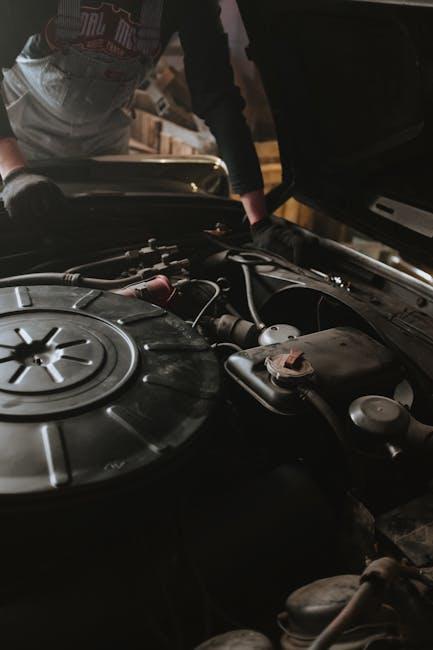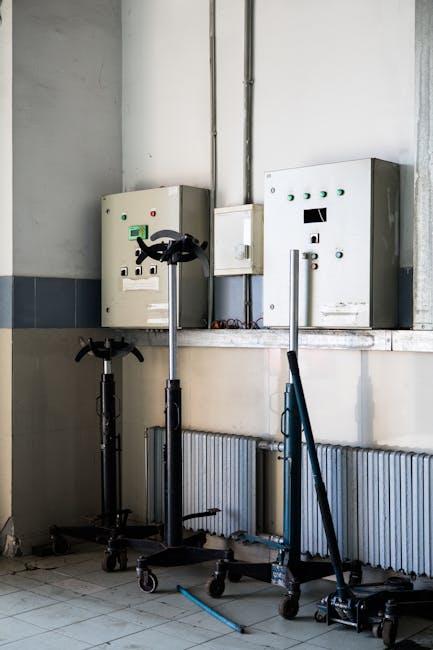In the intricate symphony of modern vehicles, electrical systems play the role of a silent conductor—powering everything from your headlights and dashboard to critical engine functions. Yet, these unseen circuits can sometimes spark unexpected problems, leaving drivers stranded or facing costly repairs. Understanding how to prevent electrical issues in your vehicle isn’t just about avoiding inconvenience; it’s about ensuring safety, reliability, and peace of mind on every journey. This article unpacks practical strategies and essential tips to help you keep your car’s electrical system running smoothly, so you can focus on the road ahead without a flicker of worry.
Table of Contents
- Understanding Common Electrical Problems in Vehicles
- The Importance of Regular Battery Maintenance
- Inspecting and Caring for Wiring and Connectors
- Choosing the Right Fuses and Relays for Your Car
- Professional Tips for Diagnosing Electrical Failures
- Preventive Habits to Extend Your Vehicle’s Electrical System Life
- Q&A
- To Wrap It Up

Understanding Common Electrical Problems in Vehicles
Electrical problems in vehicles often stem from a handful of frequent culprits, each disrupting your ride’s smooth operation. From dimming headlights and malfunctioning power windows to unexpected battery drainage, these issues typically trace back to worn-out cables, corroded connectors, or faulty fuses. Understanding the signs—such as flickering dashboard lights or difficulty starting the engine—can help pinpoint the root cause before it escalates into a costly repair. Regular inspections focusing on the battery terminals, wiring harnesses, and ground connections can reveal hidden damage caused by dirt, moisture, or constant vibration on the road.
Preventive maintenance is your best defense against the electrical gremlins lurking in your vehicle. Incorporating simple habits like cleaning battery clamps, securing loose wires, and promptly replacing blown fuses can extend the life of your car’s electrical system. Consider the following quick checklist to stay ahead of common problems:
- Inspect battery terminals for corrosion and clean as needed.
- Ensure all wiring connections are tight and free from damage.
- Test and replace fuses before they cause system failures.
- Use dielectric grease on connectors to prevent moisture buildup.
| Electrical Issue | Common Cause | Suggested Prevention |
|---|---|---|
| Dimming Headlights | Loose wiring or aging battery | Secure connections and test battery health |
| Power Window Failure | Faulty switch or blown fuse | Regular fuse check and switch maintenance |
| Battery Drain | Parasitic electrical load | Identify and remove unnecessary devices |

The Importance of Regular Battery Maintenance
Ensuring your vehicle’s battery is in top condition can save you from unexpected breakdowns and costly repairs. Regularly checking the battery terminals for corrosion and firmly tightening the connections promotes stable electrical flow. Over time, corrosion can act as a barrier, reducing the battery’s efficiency and increasing the chance of dim lights or faulty electronics. Simple practices, like wiping the terminals clean with a baking soda solution and visual inspection for cracks or leaks, can dramatically extend your battery’s lifespan and optimize your vehicle’s electrical health.
Beyond visual inspection, keeping your battery charged at the ideal voltage range is critical. Fluctuations in charge can strain your car’s electrical system and reduce battery life. Consider the following routine maintenance tips for a reliable battery:
- Test battery voltage monthly with a voltmeter or during service visits.
- Secure the battery hold-down to prevent vibrations that could cause damage.
- Inspect engine bay for fluid leaks that might corrode battery terminals.
| Battery Voltage | Condition | Recommended Action |
|---|---|---|
| 12.6V – 12.8V | Fully Charged | No action needed |
| 12.4V – 12.6V | Moderately Charged | Charge soon |
| Below 12.4V | Discharged | Recharge immediately or replace |

Inspecting and Caring for Wiring and Connectors
Maintaining the integrity of your vehicle’s wiring and connectors is essential to avoid unexpected electrical failures. Begin by visually inspecting all accessible wiring harnesses and connectors for signs of wear, corrosion, or damage. Pay close attention to areas where wires flex or pass through metal components, as these spots are prone to abrasion. Use a soft brush or compressed air to clear away dirt and debris, which can cause poor connections or short circuits. Remember, water exposure combined with dirt can accelerate rusting, so a clean, dry environment is key for long-lasting electrical health.
When handling connectors, never force them apart or together, as this can damage the terminals or locking clips. Instead, carefully unlock or unclip each connector, then inspect the pins for oxidation or bent contacts. Applying a dielectric grease can protect connectors from moisture and enhance conductivity. Here’s a quick checklist to keep your wiring in top shape:
- Regularly check for cracked insulation or exposed wires
- Ensure connectors fit snugly without looseness
- Replace damaged clips to prevent disconnections
- Use protective sleeves on wires prone to friction
| Common Issue | Prevention Tip | Tools Needed |
|---|---|---|
| Corroded Connectors | Apply dielectric grease after cleaning | Brush, dielectric grease |
| Frayed Wires | Install protective wire sleeves | Heat shrink tubing, scissors |
| Loose Connections | Secure connectors and replace clips | Pliers, replacement clips |

Choosing the Right Fuses and Relays for Your Car
When it comes to maintaining your vehicle’s electrical system, selecting the appropriate fuses and relays is crucial. These tiny heroes serve as the first line of defense against electrical surges and shorts, protecting sensitive components from damage. Opting for fuses and relays that match your car’s specifications will not only extend the life of your electrical system but also prevent unexpected failures on the road. Always consider the amperage rating, type, and compatibility with your vehicle’s make and model to keep performance smooth and safe.
To simplify your choice, keep a checklist handy highlighting the essentials:
- Amperage Rating: Ensure it matches or slightly exceeds the original fuse or relay requirement.
- Type and Size: Mini, standard, or maxi fuses; different cars call for different designs.
- Quality and Brand: Choose trusted manufacturers to avoid counterfeit or low-quality parts.
- Compatibility: Verify fitment with your vehicle’s electrical system.
| Component | Common Amperage | Typical Use |
|---|---|---|
| Fuse | 5A – 30A | Lighting, radio, sensors |
| Relay | 20A – 40A | Fuel pump, headlights, cooling fans |

Professional Tips for Diagnosing Electrical Failures
When facing electrical issues in your vehicle, systematic troubleshooting is crucial. Start by visually inspecting wiring harnesses and connectors for signs of wear, corrosion, or loose connections. Using a multimeter to check voltage continuity can help pinpoint faults that aren’t immediately visible. Remember, a stable ground connection is essential; many failures stem from poor grounding.
- Check fuses and relays for damages or burnout.
- Consult the vehicle’s wiring diagram to understand circuit pathways.
- Test each component individually before concluding it’s faulty.
Documenting your diagnostic process can save time and prevent redundant work. Use a table like the one below to track test results for key components:
| Component | Test Method | Result | Action Taken |
|---|---|---|---|
| Battery | Voltage Check | 12.6V | Pass |
| Alternator | Output Voltage | 13.8V | Pass |
| Starter Motor | Current Draw | High | Inspect Wiring |
| Fuse Box | Visual Inspection | Corroded Fuse | Replace |

Preventive Habits to Extend Your Vehicle’s Electrical System Life
Consistent care is the cornerstone of a resilient electrical system. Start by regularly inspecting your battery terminals for corrosion build-up and ensuring all connections are tight. Use a mixture of baking soda and water to clean off any corrosion—you’ll be surprised how much smoother your electrical components perform afterward. Additionally, avoid excessive use of electrical accessories such as high-powered amplifiers or aftermarket lights without upgrading your battery and alternator accordingly, as this can strain your system and shorten its lifespan.
Integrating simple habits can make a significant difference in efficiency and durability. Here’s a quick checklist to keep your vehicle’s electrical system in check:
- Turn off all accessories before shutting the engine off to prevent drain
- Schedule professional electrical diagnostics annually
- Replace worn fuses immediately to prevent short circuits
- Keep wiring away from moisture and high-heat zones
| Maintenance Task | Recommended Frequency |
|---|---|
| Battery Terminal Cleaning | Every 3 months |
| Electrical System Diagnostic | Once a year |
| Fuse Inspection | Every oil change |
| Wiring Check | Every 6 months |
Q&A
Q: Why is it important to prevent electrical issues in my vehicle?
A: Electrical systems power critical components like your lights, ignition, and infotainment. Preventing issues keeps your car running smoothly, ensures safety, and saves on costly repairs down the road.
Q: What are some common signs of electrical problems in vehicles?
A: Flickering dashboard lights, dim headlights, a dead battery, or malfunctioning accessories are red flags. Pay attention to unusual sounds or smells, which might indicate wiring troubles.
Q: How often should I have my vehicle’s electrical system checked?
A: It’s wise to have a professional inspection at least once a year or whenever you notice signs of trouble. Regular maintenance helps catch minor issues before they escalate.
Q: Can I prevent electrical problems by myself?
A: Yes! Simple steps like cleaning battery terminals, ensuring tight connections, and avoiding overloading circuits can make a big difference. However, for complex diagnostics and repairs, rely on a certified mechanic.
Q: What role does the battery play in preventing electrical issues?
A: The battery is the heart of your vehicle’s electrical system. Keeping it charged, clean, and securely mounted prevents corrosion and power loss, which are common culprits behind electrical failures.
Q: Are there any driving habits that contribute to electrical problems?
A: Frequent short trips can prevent your battery from fully charging, while neglecting to turn off accessories can drain power. Being mindful of electrical load and allowing the engine to run longer occasionally helps maintain system health.
Q: How can weather conditions affect my vehicle’s electrical system?
A: Moisture, extreme heat, or cold can damage wiring and connections. Protect your vehicle from the elements when possible and check for any signs of corrosion or wear during seasonal maintenance.
Q: Is it necessary to use original parts for electrical repairs?
A: Using manufacturer-recommended parts ensures compatibility and reliability, reducing the risk of further electrical glitches. Quality components contribute to the longevity of your vehicle’s systems.
Q: What should I do if my vehicle suddenly experiences electrical failure?
A: Safely pull over, turn off non-essential accessories, and try restarting the car. If problems persist, call for roadside assistance or take your vehicle to a trusted mechanic promptly to avoid further damage.
Q: Can preventive care extend the life of my vehicle’s electrical system?
A: Absolutely! Regular inspections, clean connections, proper battery care, and mindful usage create a robust electrical network that supports your vehicle’s performance for years to come.
To Wrap It Up
In the intricate dance of wires and circuits that power your vehicle, vigilance is your greatest ally. By understanding the common pitfalls and practicing regular maintenance, you can steer clear of electrical issues that disrupt your drive. Remember, prevention is not just about avoiding unexpected breakdowns—it’s about ensuring every journey is as smooth and safe as possible. So, keep your vehicle’s electrical system in check, and enjoy the reliable performance that comes with a well-cared-for ride. After all, a well-wired vehicle is the spark behind every adventure.

